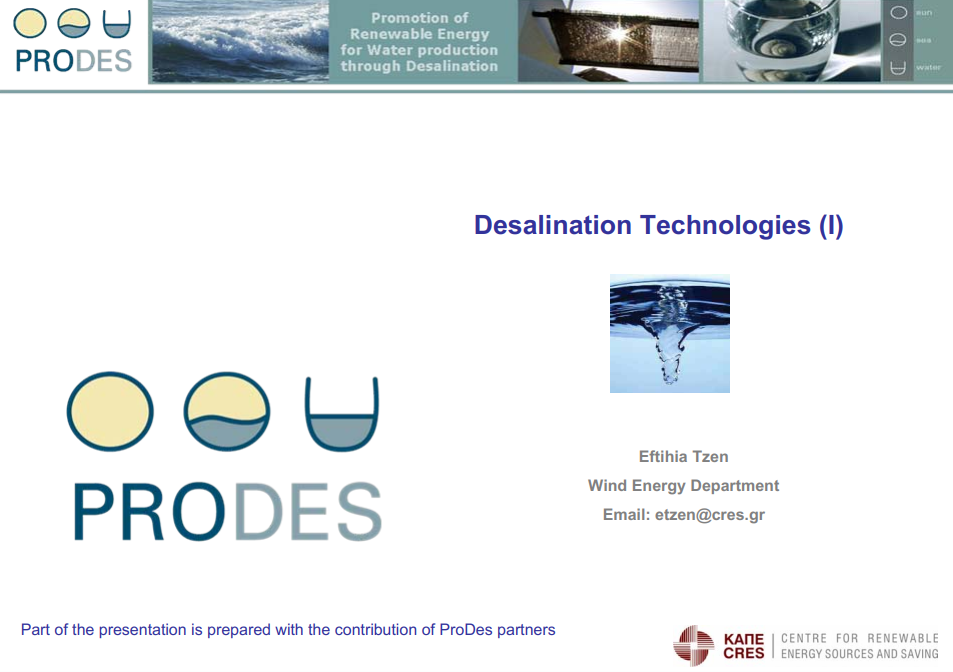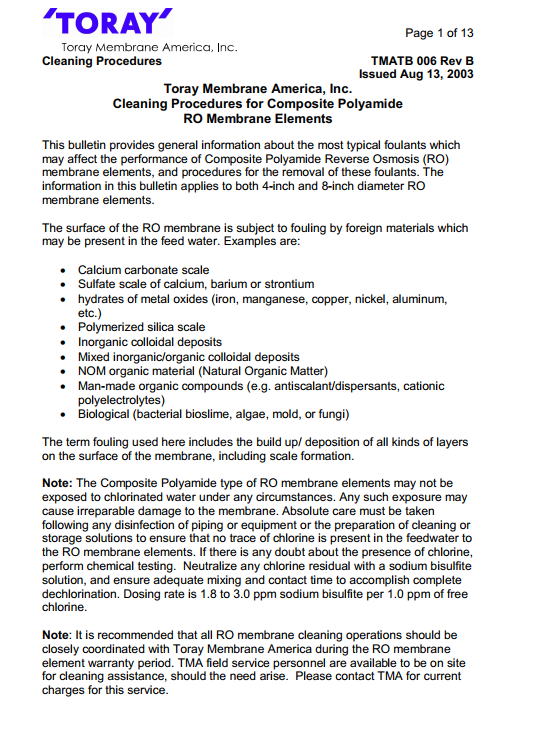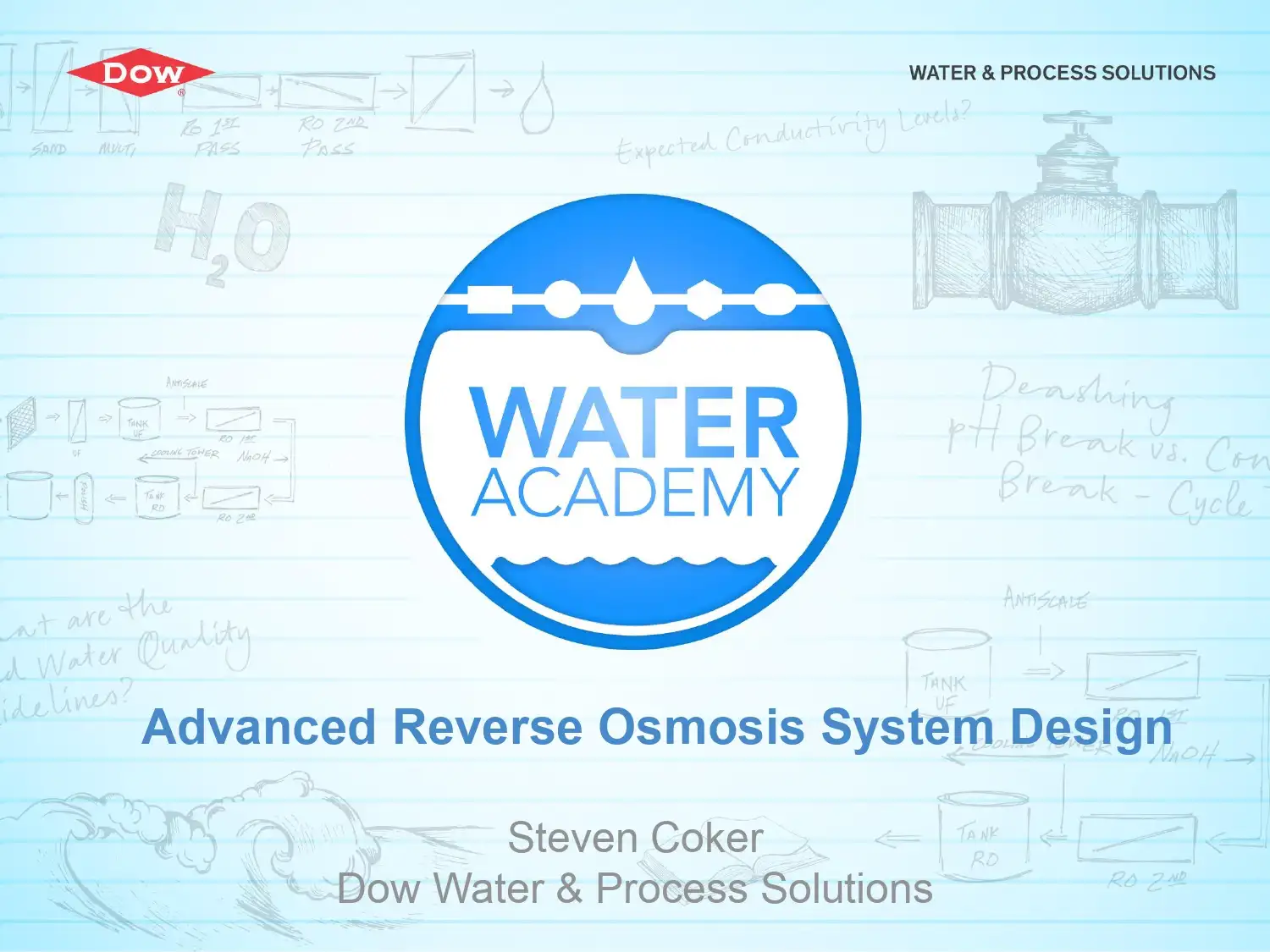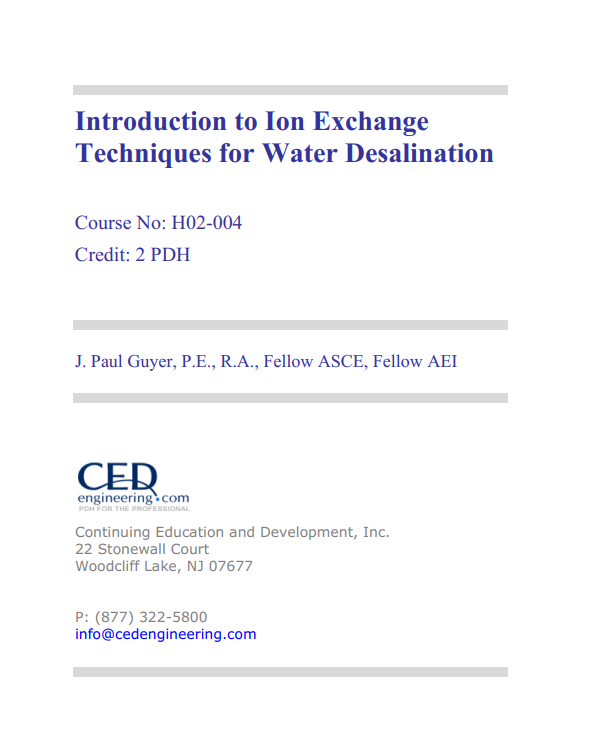Desalination Technologies
Credit to: https://www.prodes-project.org/
Eftihia Tzen
Wind Energy Department
Usually dispatched in 2 to 3 days
Usually dispatched in 2 to 3 days
Category:
Water Desalination & RO
Only logged in customers who have purchased this product may leave a review.
Related products
A Primer On Brackish And Seawater Desalination
Abstract: This publication was produced as an activity of the Texas Living Waters Project. This project
is a collaborative effort of the National Wildlife Federation, Environmental Defense, and the Lone
Star Chapter of the Sierra Club. The goals of the project are to 1) ensure adequate water for people
and environmental needs, 2) reduce future demand for water and foster efficient and sustainable use
of current water supplies, 3) educate the public and decision makers about the impact of wasteful
water use and the opportunities for water conservation, and 4) involve citizens in the decision
making process for water management.
A Primer On Brackish And Seawater Desalination
Abstract: This publication was produced as an activity of the Texas Living Waters Project. This project
is a collaborative effort of the National Wildlife Federation, Environmental Defense, and the Lone
Star Chapter of the Sierra Club. The goals of the project are to 1) ensure adequate water for people
and environmental needs, 2) reduce future demand for water and foster efficient and sustainable use
of current water supplies, 3) educate the public and decision makers about the impact of wasteful
water use and the opportunities for water conservation, and 4) involve citizens in the decision
making process for water management.
Cleaning Procedures for Composite Polyamide RO Membrane Elements
Note: The Composite Polyamide type of RO membrane elements may not be
exposed to chlorinated water under any circumstances. Any such exposure may
cause irreparable damage to the membrane. Absolute care must be taken
following any disinfection of piping or equipment or the preparation of cleaning or
storage solutions to ensure that no trace of chlorine is present in the feedwater to
the RO membrane elements. If there is any doubt about the presence of chlorine,
perform chemical testing. Neutralize any chlorine residual with a sodium bisulfite
solution, and ensure adequate mixing and contact time to accomplish complete
dechlorination. Dosing rate is 1.8 to 3.0 ppm sodium bisulfite per 1.0 ppm of free
chlorine
Cleaning Procedures for Composite Polyamide RO Membrane Elements
Note: The Composite Polyamide type of RO membrane elements may not be
exposed to chlorinated water under any circumstances. Any such exposure may
cause irreparable damage to the membrane. Absolute care must be taken
following any disinfection of piping or equipment or the preparation of cleaning or
storage solutions to ensure that no trace of chlorine is present in the feedwater to
the RO membrane elements. If there is any doubt about the presence of chlorine,
perform chemical testing. Neutralize any chlorine residual with a sodium bisulfite
solution, and ensure adequate mixing and contact time to accomplish complete
dechlorination. Dosing rate is 1.8 to 3.0 ppm sodium bisulfite per 1.0 ppm of free
chlorine
Desalination Needs and Appropriate technology
Abstract
This study investigates the desalination needs and available technologies in Sri Lanka. Lack of rainfall, pollution due to agricultural chemicals, presence of fluoride, increasing demand, exploitation of ground water and brackishness have created scarcity of fresh pure water specially in near costal and dry zones in Sri Lanka. Due to Chronic Kidney Disease (CKD) around 500 people died in dry zones annually which is suspected to cause by Arsenic and Cadmium contain
in ground water due to agriculture chemicals. The available desalination methods are Reverse Osmosis (RO), Solar distillation and conventional methods. The cost for RO is Rs.0.10 cents per liter and solar distillation Rs.2.96 per liter. Although the price shows that the RO is better but due to high initial investment as a
third world country it is very difficult to afford huge initial investment without government intervention. The experimental solar desalination units only produce nearly 5liters of potable water per day and directly impacted by availability of solar radiation.
The energy availability of Sri Lanka and future potable water demand predicted as 2188.3 Mn liters as maximum demand which will be in 2030, therefore by that time the government should have a proper plan to cater the demand and desalination plants need to be planned and built based on the demand of dry zones and specially agriculture areas. The applicability of renewable energy for desalination in local arena was also simulated taking the Delft Reverse Osmosis plant for the simulation. Results show that the optimum design is combination of Solar PV and existing 100kW Diesel generator Set with Battery bank and
converter.
Desalination Needs and Appropriate technology
Abstract
This study investigates the desalination needs and available technologies in Sri Lanka. Lack of rainfall, pollution due to agricultural chemicals, presence of fluoride, increasing demand, exploitation of ground water and brackishness have created scarcity of fresh pure water specially in near costal and dry zones in Sri Lanka. Due to Chronic Kidney Disease (CKD) around 500 people died in dry zones annually which is suspected to cause by Arsenic and Cadmium contain
in ground water due to agriculture chemicals. The available desalination methods are Reverse Osmosis (RO), Solar distillation and conventional methods. The cost for RO is Rs.0.10 cents per liter and solar distillation Rs.2.96 per liter. Although the price shows that the RO is better but due to high initial investment as a
third world country it is very difficult to afford huge initial investment without government intervention. The experimental solar desalination units only produce nearly 5liters of potable water per day and directly impacted by availability of solar radiation.
The energy availability of Sri Lanka and future potable water demand predicted as 2188.3 Mn liters as maximum demand which will be in 2030, therefore by that time the government should have a proper plan to cater the demand and desalination plants need to be planned and built based on the demand of dry zones and specially agriculture areas. The applicability of renewable energy for desalination in local arena was also simulated taking the Delft Reverse Osmosis plant for the simulation. Results show that the optimum design is combination of Solar PV and existing 100kW Diesel generator Set with Battery bank and
converter.
Advanced Reverse Osmosis System Design
Overview of Advanced RO Design
• RO system design guideline variables
• Drivers for RO system configuration selection
• Principles and benefits of RO array flux balancing
• Array selection criteria to achieve permeate quality target
• Energy recovery
Advanced Reverse Osmosis System Design
Overview of Advanced RO Design
• RO system design guideline variables
• Drivers for RO system configuration selection
• Principles and benefits of RO array flux balancing
• Array selection criteria to achieve permeate quality target
• Energy recovery
Cleaning Your RO
Eventually the day comes when your RO system will require cleaning. Cleaning is recommended when your RO shows evidence of fouling, just prior to a long term shutdown, or as a matter of scheduled routine maintenance. Fouling characteristics that signal you need to clean are a 10-15% decrease in normalized permeate flow, a 10-15% decrease in normalized permeate quality, or a 10-15% increase in normalized pressure drop as measured between the feed and concentrate headers
Cleaning Your RO
Eventually the day comes when your RO system will require cleaning. Cleaning is recommended when your RO shows evidence of fouling, just prior to a long term shutdown, or as a matter of scheduled routine maintenance. Fouling characteristics that signal you need to clean are a 10-15% decrease in normalized permeate flow, a 10-15% decrease in normalized permeate quality, or a 10-15% increase in normalized pressure drop as measured between the feed and concentrate headers
Desalination Plant Basis Of Design
Overview:
The project potable water requirements will be provided using single desalination plant with the Grand Bahama Port Authority water supply serving as the backup source. The overall desalination treatment process will consist of feedwater pumping, bag filtration, optional media filtration, the addition of a scale
inhibitor, cartridge filtration, membrane separation, forced air degasification, re-pumping, and post treatment. Provisions have been included to bypass the post treatment systems for the production of irrigation water. The post aeration re-pump station will be designed to transfer either type of water to the
appropriate storage tanks located within the project. Membrane concentrate will be disposed via an injection well to be constructed as part of this project.
The desalination process will consist of a dual treatment units or “trains” each equipped with a positive displacement axial piston first pass membrane feed pump, first pass membrane array, energy recovery system, second pass membrane feed pump, second pass membrane array, high- and low-pressure
piping and instrumentation. The second pass system is designed to treat up to 60 percent of the first pass permeate. A membrane cleaning/flush system will be provided. The membrane post treatment will be designed to receive the flow from both units and consists of a forced air degasified, repumping, recarbonation, calcium carbonate up flow contactors to boost finished water hardness and alkalinity concentrations; and three chemical feed systems for the metering of a corrosion inhibitor, dilute hydrochloric acid for pH adjustment and sodium hypochlorite for residual disinfection. The final pH and chlorine residual will be controlled and recorded by a separate system. The following sections describe the various aspects of the facility in greater detail. Process flow
schematics are presented in Appendix A.
Desalination Plant Basis Of Design
Overview:
The project potable water requirements will be provided using single desalination plant with the Grand Bahama Port Authority water supply serving as the backup source. The overall desalination treatment process will consist of feedwater pumping, bag filtration, optional media filtration, the addition of a scale
inhibitor, cartridge filtration, membrane separation, forced air degasification, re-pumping, and post treatment. Provisions have been included to bypass the post treatment systems for the production of irrigation water. The post aeration re-pump station will be designed to transfer either type of water to the
appropriate storage tanks located within the project. Membrane concentrate will be disposed via an injection well to be constructed as part of this project.
The desalination process will consist of a dual treatment units or “trains” each equipped with a positive displacement axial piston first pass membrane feed pump, first pass membrane array, energy recovery system, second pass membrane feed pump, second pass membrane array, high- and low-pressure
piping and instrumentation. The second pass system is designed to treat up to 60 percent of the first pass permeate. A membrane cleaning/flush system will be provided. The membrane post treatment will be designed to receive the flow from both units and consists of a forced air degasified, repumping, recarbonation, calcium carbonate up flow contactors to boost finished water hardness and alkalinity concentrations; and three chemical feed systems for the metering of a corrosion inhibitor, dilute hydrochloric acid for pH adjustment and sodium hypochlorite for residual disinfection. The final pH and chlorine residual will be controlled and recorded by a separate system. The following sections describe the various aspects of the facility in greater detail. Process flow
schematics are presented in Appendix A.
Desalination At A Glance
Introduction:
By desalination, we will be referring to the production of a useful product water from a feed
water that is too high in inorganic materials (salts) to be useful. The feed water may be
seawater, brackish water, or other “impaired” water that cannot be used directly for potable
or general industrial purposes. Notice that this definition includes the treatment of certain
wastewaters for subsequent reuse.
The principal technologies used in desalination are based on concepts that are fairly easy to
grasp by those with a modest amount of scientific training and/or technical experience. In
practice, however, choices of technology and plant design are usually determined by factors
that might appear minor to the inexperienced. Similarly, new technologies that show great
promise in the laboratory frequently fail for reasons that were earlier overlooked or dismissed
as trivial. Indeed, professional fascination with specific technical elegance has, in some
cases, led researchers to remain oblivious to inherent limitations of a process. Nonetheless,
attention to detail over the past five decades has resulted in dramatic reductions in capital
and operating costs as well as greatly increased plant reliability and performance
Desalination At A Glance
Introduction:
By desalination, we will be referring to the production of a useful product water from a feed
water that is too high in inorganic materials (salts) to be useful. The feed water may be
seawater, brackish water, or other “impaired” water that cannot be used directly for potable
or general industrial purposes. Notice that this definition includes the treatment of certain
wastewaters for subsequent reuse.
The principal technologies used in desalination are based on concepts that are fairly easy to
grasp by those with a modest amount of scientific training and/or technical experience. In
practice, however, choices of technology and plant design are usually determined by factors
that might appear minor to the inexperienced. Similarly, new technologies that show great
promise in the laboratory frequently fail for reasons that were earlier overlooked or dismissed
as trivial. Indeed, professional fascination with specific technical elegance has, in some
cases, led researchers to remain oblivious to inherent limitations of a process. Nonetheless,
attention to detail over the past five decades has resulted in dramatic reductions in capital
and operating costs as well as greatly increased plant reliability and performance
Desalination Technology Trends And CH2M HILL
Presentation Outline:
- The Growing Desalination Market
- Trends in the Technology/Virtual expo
- Thermal Desalination
Desalination Technology Trends And CH2M HILL
Presentation Outline:
- The Growing Desalination Market
- Trends in the Technology/Virtual expo
- Thermal Desalination
Desalination and Water Treatment
Abstract:
This study proposes a simple design method of the Reverse osmosis (RO) system in RO brackish water desalination plants. This method is based on the application of maximum available recovery without scaling of any of the compounds present in the water as silica, calcium carbonate, calcium sulfate, barium sulfate, strontium sulfate, and calcium fluoride, and membrane manufacturer design guidelines, and the plant production. Although the method was originally
conceived for application to subterranean brackish waters in the Canary Islands, Spain (principally Gran Canaria, Fuerteventura and Tenerife), it can be extrapolated to other types of region and water treatable with RO systems. The required input data are the chemical composition of the feed water, pH, temperature, silt density index membrane manufacturer design guidelines, and the plant production. The programmed method then determines the design of the RO system. The method whose procedure is described graphically and analytically can be used as an aid in design optimization of RO brackish water desalination plants with acid-free pretreatment processes and only the use of scale inhibitor using spiral wound membranes. Practical applications are presented. The final results for different types of feed water and capacities are showed.
Desalination and Water Treatment
Abstract:
This study proposes a simple design method of the Reverse osmosis (RO) system in RO brackish water desalination plants. This method is based on the application of maximum available recovery without scaling of any of the compounds present in the water as silica, calcium carbonate, calcium sulfate, barium sulfate, strontium sulfate, and calcium fluoride, and membrane manufacturer design guidelines, and the plant production. Although the method was originally
conceived for application to subterranean brackish waters in the Canary Islands, Spain (principally Gran Canaria, Fuerteventura and Tenerife), it can be extrapolated to other types of region and water treatable with RO systems. The required input data are the chemical composition of the feed water, pH, temperature, silt density index membrane manufacturer design guidelines, and the plant production. The programmed method then determines the design of the RO system. The method whose procedure is described graphically and analytically can be used as an aid in design optimization of RO brackish water desalination plants with acid-free pretreatment processes and only the use of scale inhibitor using spiral wound membranes. Practical applications are presented. The final results for different types of feed water and capacities are showed.
California Desalination Planning Handbook
Introduction:
Desalination is receiving increased attention as a means for addressing the water supply challenges of California. Growing population, much of which is located in semi-arid regions of the state, and various other water demands pose increased pressure on existing water supplies. Much of California’s water supply depends on snow accumulation in the winter, providing spring runoff that flls reservoirs and replenishes often depleted groundwater supplies. But in periods of drought, water supply shortages can be encountered throughout the state, particularly in the central valley and southern portion of the state. All indications suggest the impacts of global warming will include a change in the timing of runoff and less snowfall. This will put more pressure on existing supplies, and exacerbate the impacts of drought. As the implications of global warming become clearer, more emphasis will likely be given to developing
new sources of water supply to meet existing and projected demand. While conservation and recycling are recommended as the frst course of action, other alternatives (such as desalination and increased surface and groundwater storage) are receiving increased attention.
California Desalination Planning Handbook
Introduction:
Desalination is receiving increased attention as a means for addressing the water supply challenges of California. Growing population, much of which is located in semi-arid regions of the state, and various other water demands pose increased pressure on existing water supplies. Much of California’s water supply depends on snow accumulation in the winter, providing spring runoff that flls reservoirs and replenishes often depleted groundwater supplies. But in periods of drought, water supply shortages can be encountered throughout the state, particularly in the central valley and southern portion of the state. All indications suggest the impacts of global warming will include a change in the timing of runoff and less snowfall. This will put more pressure on existing supplies, and exacerbate the impacts of drought. As the implications of global warming become clearer, more emphasis will likely be given to developing
new sources of water supply to meet existing and projected demand. While conservation and recycling are recommended as the frst course of action, other alternatives (such as desalination and increased surface and groundwater storage) are receiving increased attention.















Reviews
There are no reviews yet.